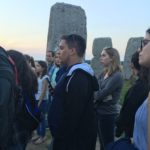On Thursday we all trooped off to the train station and took three different trains to get to Salisbury. Salisbury is a quaint little city south west of Oxford. We checked into our quirky hotel and then walked over to visit Salisbury Cathedral and see the Magna Carta on display. The students really were impressed by the 13th century cathedral and the Magna Carta.
At 7:30 taxis arrived to take us out to the Salisbury Plain and Stonehenge. We had a private visit where we were allowed to walk amidst the stones. Our guide, Romy, told the story of the site and the students truly enjoyed the entire experience, especially trying her dousing rods to measure the energy veins through the main portal. We witnessed a lovely sunset and arrived back at the hotel around 10:30 pm.
 The next day we visited the Museum to see the archeological finds around Stonehenge and some other delightful exhibits. Back to Oxford via our three trains!
The next day we visited the Museum to see the archeological finds around Stonehenge and some other delightful exhibits. Back to Oxford via our three trains!
This weekend a group of them went into London for the Pride Parade and other places. We re-convene as a group on Monday as we head into our final week.
Certainly Stonehenge offers many opportunities to reflect on the nature of place. Its very mystery and status as pre-historic offer us slices of time where it meant this or that. Or can we ever grasp what the 3rd millennial BCE humans saw as the world around them? I was struck by how many of the students face-timed their families back home while we were on the site. 21st century channels the sacred silence of the stones. But I also expect that London with its parade in support of Gay Rights will also offer rich food for reflecting on how we shape our rituals and honor one another.
If you would prefer a slightly more reflective take on our visit, see my post in Medium.









